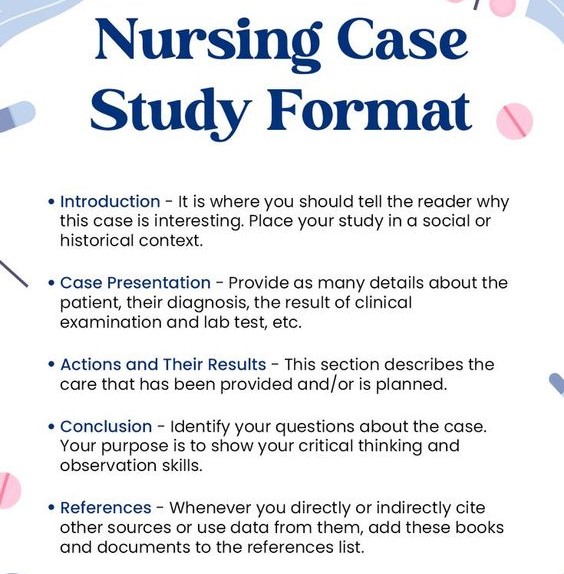The art of critical care nursing lies in navigating the complexities of acutely ill patients. It requires nurses to make swift and informed decisions in high-pressure situations. A critical care nursing case study serves as a powerful tool to capture this dynamic process. It allows you a platform for reflection, analysis, and knowledge sharing. The case study also allows nurses to delve deep into a specific patient's journey and explore the intricacies of care, the challenges and lessons encountered.
This guide will equip you with the essential tools and insights to craft a compelling critical care nursing case study that informs and inspires.
Steps for Writing a Stellar Critical Care Nursing Case Study
1. Choosing Your Story: The Foundation of an Effective Case Study
The first step towards writing a captivating critical care nursing case study is selecting a patient story. The ideal story should be one that resonates with you. The ideal case study offers a unique combination of:
- Clinical Significance: The patient's condition or experience presents a compelling challenge or opportunity for learning in critical care nursing. This could be a rare diagnosis, a complex intervention, or a challenging ethical dilemma.
- Personal Connection: You feel a strong connection to the patient's story, either due to the severity of their illness, the complexity of their care, or the remarkable resilience they demonstrate.
- Learning Potential: The case study holds the potential to teach valuable lessons to fellow nurses, contribute to knowledge in the field, and inspire future practice.
2. Gathering the Information: Building the Narrative Foundation
Once you've chosen your story, the next step involves meticulous information gathering. This involves:
- Patient Chart Review: Thoroughly review the patient's medical record, including their admission notes, progress notes, vital signs, medications, lab results, and imaging studies. This will provide a comprehensive picture of the patient's clinical course.
- Nursing Documentation: Carefully analyze your nursing notes, assessments, interventions, and communication with other healthcare providers. This will highlight your crucial role in the patient's care and provide valuable insights into their journey.
- Patient Interviews: With appropriate patient consent and respecting confidentiality, conduct a thorough interview with the patient to gain their perspective on their experience. This allows you to capture their thoughts, feelings, and insights into their illness.
- Family Interviews: Interviewing the patient's family members can provide invaluable context and support to your critical care nursing case study. Their insights into the patient's pre-illness status, their fears and concerns, and their perspectives on care can add a human dimension to your narrative.
- Literature Review: Conduct a thorough literature review on the patient's specific condition, related nursing interventions, and best practices in critical care nursing. This will provide evidence-based support for your decisions and enhance the credibility of your case study.
3. Structuring the Narrative: Crafting a Compelling Story
The structure of your critical care nursing case study is crucial for delivering a clear, engaging, and insightful narrative. Consider this framework:

a. Introduction:
- Patient Profile: Begin by introducing the patient, providing relevant background information about their age, gender, medical history, and presenting complaint.
- Setting the Scene: Set the stage by outlining the patient's initial presentation and the critical care environment where their story unfolds. Highlight the unique challenges and complexities associated with their case.
b. Clinical Presentation and Assessment:
- Patient's Story: Describe the patient's symptoms, signs, and the initial assessment findings that led to their admission to the critical care unit. Use specific details and incorporate direct quotes from the patient or family members to personalize the narrative.
- Diagnosis and Treatment: Outline the patient's confirmed diagnosis, the treatment plan, and the rationale behind it. Highlight the relevant medical interventions and therapies administered.
c. Nursing Interventions and Strategies:
- Critical Care Nursing Role: Describe your role as the critical care nurse, the unique challenges you faced, and the specific nursing interventions you implemented.
- Collaboration and Communication: Detail your collaboration with other healthcare providers (physicians, respiratory therapists, pharmacists, etc.) and the communication strategies used to ensure optimal patient care.
- Evidence-Based Practice: Link your nursing interventions to evidence-based guidelines and best practices in critical care nursing. Explain the rationale behind your decisions and how they contributed to the patient's well-being.
d. Patient Outcomes and Reflection:
- Patient Progress: Trace the patient's clinical course, highlighting significant changes in their condition, response to treatment, and eventual outcome.
- Lessons Learned: Reflect on the patient's journey, emphasizing the key lessons learned regarding critical care nursing practice, communication, collaboration, and patient-centered care.
- Future Recommendations: Based on your reflections and the patient's experience, suggest potential areas for improvement in critical care nursing practice, future research directions, and areas for ongoing education and training.
4. Writing Style and Language: Elevating the Narrative
The language you use in your critical care nursing case study is crucial for capturing the reader's attention and conveying the the patient's story. Consider these elements:
- Clear and Concise: Use precise and clear language to convey complex medical concepts and nursing interventions. Avoid jargon or technical terms that may confuse readers outside of the healthcare field.
- Engaging and Empathetic: Write with a compassionate voice that conveys your empathy for the patient's suffering and your dedication to their care. Use vivid descriptions to evoke emotions and connect with the reader on a personal level.
- Active Voice: Use active voice to highlight the nurse's actions and decision-making process. For example, instead of "The patient's blood pressure was monitored," write "The nurse meticulously monitored the patient's blood pressure every hour."
- Narrative Structure: Employ storytelling techniques to weave a compelling narrative. This could involve focusing on pivotal moments in the patient's journey, highlighting key decisions you made, or exploring the patient's own thoughts and feelings about their experience.
5. Ethical Considerations: Protecting Patient Confidentiality
Ethical considerations are paramount when writing a critical care nursing case study. Always adhere to patient privacy and confidentiality guidelines.
- Informed Consent: Obtain informed consent from the patient (or their legal representative) before using their story in a case study.
- Anonymity and De-identification: Protect patient anonymity by using fictitious names and altering identifying details to ensure their privacy is maintained.
- Confidentiality: Avoid sharing any sensitive information that could compromise the patient's identity or their right to privacy. This includes details about their personal life, employment, or social relationships.
- Respectful Language: Use respectful and non-judgmental language throughout your case study. Avoid any terms or phrases that could be construed as offensive or discriminatory.

6. Visuals and Multimedia: Enhancing Engagement
Adding visual elements and multimedia can further enhance the engagement and impact of your critical care nursing case study.
- Photographs and Images: Include relevant photographs (with patient consent) or medical images (like X-rays or EKGs) to visually illustrate the patient's condition and the interventions you implemented.
- Graphs and Charts: Use graphs or charts to depict the patient's vital signs, laboratory results, and other relevant data in a clear and visually appealing manner.
- Audio Recordings: If appropriate and with patient consent, include audio recordings of patient interviews or nurse-patient interactions to add an auditory dimension to the narrative.
7. Disseminating Your Case Study: Sharing Your Insights
Once your critical care nursing case study is complete, consider these options for sharing your insights with the nursing community:
- Professional Journals: Submit your case study to peer-reviewed nursing journals that publish case studies in critical care nursing.
- Nursing Conferences: Present your case study at regional or national nursing conferences to share your insights with a wider audience.
- Hospital Newsletters or Websites: Share your case study with your colleagues and other healthcare professionals within your institution.
- Online Platforms: Utilize online platforms like nursing blogs or social media groups to disseminate your case study. You should also engage in discussions with fellow nurses.
Critical Care Nursing Case Study Example
Here's a sample outline for a critical care nursing case study illustrating the application of these principles:
Title: "Managing Sepsis: A Case Study in Critical Care Nursing"
Introduction:
- Patient Profile: Introduce Mr. Johnson, a 72-year-old male with a history of diabetes and hypertension, who presented with fever, hypotension, and altered mental status.
- Setting the Scene: Describe the patient's admission to the critical care unit and the unique challenges of managing sepsis in an elderly patient with comorbidities.
Clinical Presentation and Assessment:
- Patient's Story: Detail Mr. Johnson's symptoms, signs, and initial assessment findings. Include his vital signs, laboratory results, and his family's account of his declining condition.
- Diagnosis and Treatment: Outline the diagnosis of sepsis and the multidisciplinary approach to treatment. You should include antibiotics, fluid resuscitation, and other supportive measures.
Nursing Interventions and Strategies:
- Critical Care Nursing Role: Describe your role in monitoring Mr. Johnson's condition, administering medications, and providing supportive care. Highlight the challenges of managing his fluctuating vital signs and ensuring timely communication with the medical team.
- Collaboration and Communication: Detail your collaboration with the physician, pharmacist, and respiratory therapist, emphasizing the importance of clear and concise communication to ensure optimal patient care.
- Evidence-Based Practice: Link your nursing interventions to evidence-based guidelines for sepsis management, explaining the rationale behind your decisions and how they contributed to Mr. Johnson's recovery.
Patient Outcomes and Reflection:
- Patient Progress: Trace Mr. Johnson's clinical course, highlighting his response to treatment, the turning points in his recovery, and his eventual discharge from the critical care unit.
- Lessons Learned: Reflect on the case study, emphasizing the importance of early recognition of sepsis, prompt intervention, and effective communication for achieving positive outcomes.
- Future Recommendations: Suggest potential areas for improvement in critical care nursing practice, future research directions, and areas for ongoing education and training in sepsis management.
Final Thoughts
Reiterate the key takeaways from the case study, highlighting the importance of critical care nursing skills, collaboration, and evidence-based practice in managing complex patient conditions like sepsis.

Remember, every critical care nursing case study is a unique story. You can create a valuable resource for fellow nurses by choosing a compelling case, gathering information, crafting a compelling narrative, and adhering to ethics. You could also contribute to the advancement of knowledge in the field, and inspire future generations of critical care professionals.
Get the Best Critical Care Nursing Case Study Writing Help
At Exemplary Dissertations, we offer professional nursing case study writing help for undergraduate, Degree, Master’s and Doctorate. Our writers can assist you with topic suggestion, case study writing, proofreading, editing and plagiarism removal. Besides, we also provide help with writing nursing research papers, essays and dissertations.